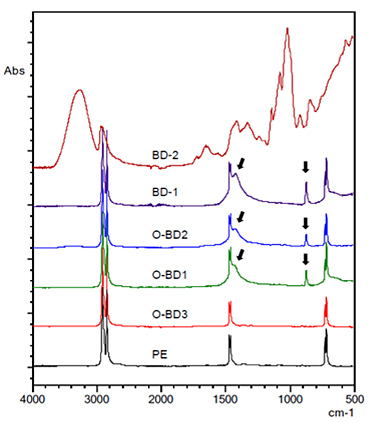Biodegradable Plastics

Polyethylene (PE), polypropylene (PP) and polystyrene (PS) , made from petroleum-based polymers, are not expensive and durable, so they are used in many plastic products. Recently, the environmental pollution problem caused by microplastics has become a global concern, and how to limit their impact on the environment is being discussed. In order to reduce plastic waste, the development of eco-friendly alternative materials is being promoted. As an alternative, biomass plastics and biodegradable plastics are becoming more widely available.
Biodegradable Plastics are plastics that are decomposed into low-molecular compounds by microorganisms in the environment. So they break down easily in nature, which is an opposite characteristic of petroleum-based plastics. They are recommended for single-use products. At this time, it is true they are inferior to petroleum-based plastics in the features of durability and functionality, so research and development of new materials is on going for a reliable solution.
Qualitative and Thermal Analysis for Degradable plastic bags
Qualitative analysis is conducted using a Fourier Transform Infrared Spectrometer (FT-IR) and thermal analysis is conducted using a differential Scanning Calorimeter (DSC) and thermogravimetric analyzer (TGA) for oxo-biodegradable and biodegradable plastic bags. These testing methods are utilized for new material development.

Infrared absorption spectra of oxo-biodegradable (O-BD1,O-BD2, O-BD3) and biodegradable (BD-1)
Infrared absorption spectra of oxo-biodegradable (O-BD1,O-BD2, O-BD3) and biodegradable (BD-1) are similar with the spectrum of polyethylene plastic bags. It also shows that those plastic bags contain the calcium carbonate (CaCO3) as an inorganic filler corresponding to the specific absorption peak caused by CaCO3.

This data is the TGA curves of each plastic bag. This shows each bag has different thermal features. Click below to see the detail.
Application news
Characterization of Biodegradable and Oxo-Biodegradable Plastic Bags
Quantitative Analysis for Single-use Biodegradable Plastic Products

Single-use biodegradable plastic products (Left) and Infrared absorption spectra of spoon and PLA (Right)
The result of FT-IR analysis for the single-use biodegradable plastic spoon is very similar with PLA resin. It also shows some peaks coming from talc filled in products are observed in the spectrum.
Article
(links to Shimadzu Europa GmbH website)
Evaluation of Degradability of Biodegradable plastics
It is important to understand the degradable process of biodegradable plastics for the new material development and environmental considerations. There are now some projects under ISO and other organizations to evaluate the degradability of biodegradable plastics. We are also considering how to contribute to the evaluation of degradability utilizing our analytical technologies as the Total Organic Carbon (TOC) analyzer, Liquid Chromatograph Mass Spectrometry, and other measurement methods.
Webinar
Analysis of Recycled Plastics and Biodegradable Plastics with FTIR
(links to Shimadzu YouTube Channel)


